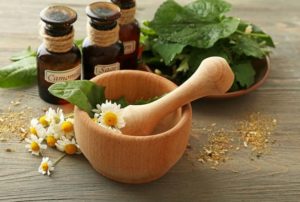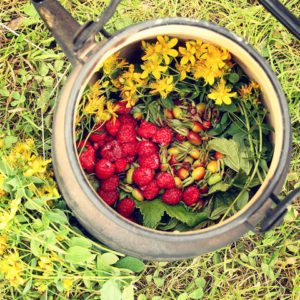-Pam Scott-

I truly love the jolt of drinking a strong cup of Earl Grey tea; it sends me into a creative whirlwind like nothing else. A pot of strong black tea has been the elixir to kick start my day and offer an intense “pick me up” for almost half a century. But .. alas, this roller coaster ride of caffeine can have its consequences when it comes to stable blood pressure and healthy digestion.
Growing, blending and brewing my own herbal teas has led me to a new appreciation of the healing and healthful benefits of herbs. Sitting down to a warm pot of tea can be centering, meditative and restorative as well as a delightful way to enjoy its healthful and nutritional benefits. Some herbs taken as tea can address acute symptoms such as coughs, sore throats and stomach ailments. Other herbs can have an effect on emotional health, dealing with stress, anxiety, sleep patterns and mood swings. Some herbs are quite effective in aiding the absorption of nutrients from food. Others will detox and cleanse the bod’s systems.
Moderation and thoughtful consideration need to be used when using herbs medicinally. I cannot stress enough that herbs are powerful medicine; in fact many herbs are used or are the prototypes for many of our modern medicines. When making herbal teas you are extracting powerful phytonutrients from the plants, so be aware of any allergies or health issues that may be affected by drinking these plant extracts. Always consult a certified herbalist or physician if you are using herbs medicinally.
Growing and drying your own herbs for tea is pretty easy. You will need lots of sunlight, moderately nutrient-rich soil with good drainage, and moderate rainfall. Some herbs will grow profusely, some will reseed in odd places such as cracks in the driveway, and some will need a bit of nurturing by wintering over indoors. Some herbs you can start from seed, some you can buy as shrubs or annual/ perennial starts.

When harvesting your herbs, pick a dry day after the dew has dried but before the heat of the day dissipates the oils on the leaves. Dry your herbs by hanging them upside down in a warm, dry room. You can also hang them in baskets, or if you are harvesting a large quantity you can use the fabulous Grower’s Edge Dry Rack that we sell here at Fifth Season. If using the roots of herbs such as Ashwagandha or Echinacea, pull the roots in late autumn when the plants send energy down to the roots. Chop them before drying. I use a dehydrator to dry roots and berries. Just before brewing you may want to use a mortar and pestle to break up larger roots, berries and leaves. The aim is to break them up, not powder them.

When brewing delicate leaves or flowers you just need enough heat to release their oils, too much heat will destroy the oils and flavor. I usually brew these more delicate herbs with 195 degree water. Harder stems, roots and berries need boiling water to release their oils. As the tea cools you can then add the more delicate herbs. Keep a lid on the pot while brewing to keep the essential oils from dissipating. Most herbs brew from 3-7 minutes. If using city tap water, always brew with filtered water, it tastes so much better.
When blending your teas start with an active ingredient chosen for its metabolic benefits such as immunity, calming the nervous system, or antiviral properties. Next choose an herb that supports the mechanical parts of the body such as the sinuses, muscle and joint care, or fever reduction. Then choose an herb for taste such as lavender, mint or fennel. The traditional formula for this tea blending is: 3 parts metabolic; 2 parts mechanical; 1 part flavoring. But really you can pretty much blend your teas to suit your taste.
Adding lemon to tea not only tastes good but will also boost the antioxidant activity of some herbs. Adding honey to tea adds taste and also contains antioxidants. Cinnamon added to tea can lower blood sugar levels. Ginger is often added to tea and has an anti inflammatory effect.

The following is a list of some of the herbs I have found easy to grow here in central Virginia (horticultural zone 7). Some of these are not zone 7 hardy. I grow them in pots for wintering over indoors. You can find these herbs as seeds, shrubs, annuals or perennial starts or as cut dried tea herbs, plus a huge array of flavoring herbs and spices, here at Fifth Season Gardening. Check with your local store to see what is in stock, as each location is unique. I have also included a few recipes for some of my “go to” tea blends.
Ashwagandha – has a mildly sedative effect. Use the dried root. Grow from seed or start. Not winter hardy, winter over inside.
Borage – Treats stress, high blood pressure and depression. Use leaves and flowers. Grow from seed or start.
Calendula – Treats inflammation, lymph function, good for skin care and is antifungal Use the flowers. Grow from seed.
German Chamomile – Treats stress, insomnia, digestive issues, colic. Use flowers. Grow from seed.
Chokeberry (Aronia) – Treats digestive issues, helpful for weight loss, anti inflammatory, antioxidant. Use berries. Grow from perennial shrub.
Echinacea – Stimulates the immune system, use during cold or flu, treats inflammation, arthritis. Use flowers and roots. Slow to start from seed, buy Perennial start.
Elderberry – Treats colds and fevers, hay fever and allergies, antiviral, immune booster. Use flowers and berries. Plant as a shrub.
Hibiscus Roselle – Great source of vitamin C, Treats colds and flu, normalizes blood pressure. Use flower calyx. Start from seed indoors in early spring or buy starts.
Lavender – Calms the nerves, improves sleep, relieves muscle tension. Use flowers and leaves. Start from seed or buy starts.
Lemon Balm – Antiviral, relieves stress and tension, mood elevator. Use leaves. Plant from seed, slow to come up, buy starts.
Lemon Verbena – Sleep aid. Use leaves, Buy start, grow in a pot to bring inside for the winter.
Meadowsweet (filipendula) – Treats indigestion, reduces acidity in the body, Treats arthritis, promotes restorative sleep. Use flowers. Plant as a perennial start.
Mint – Antiseptic, antifungal, antiviral, treats colds and flu, headaches.
Moringa – Anti inflammatory, improves digestion, mood elevator, full of nutrients. Use leaves. Plant from seed, buy start. Grow in pot to winter over indoors.
Raspberry – High in nutrients, pain reliever, treats anemia, flu, muscle cramps, nausea, osteoporosis. Use leaves and berries, grow from root slips or potted plant.
Rose geranium- Treats digestive upsets, use as flavoring. Use leaves. Buy plant or start from cuttings. Plant in pot to winter indoors.
Rosemary- Improves memory, boosts energy, increases blood flow. Use leaves. Plant as a start, slow to come up from seed. Can be a tender perennial.
Tulsi- Balances blood sugar, reduces anxiety, lowers blood pressure. Use leaves. Grow from seed or start.
Headache and Stress Tea
Mix- 3t dried Rosemary, 2 t dried Lemon Balm, 1⁄2 t dried Lavender per cup of 195-degree water. Steep covered 3-5 minutes.
Mood Enhancer Tea
Mix- 1t dried Hibiscus Flower, 3t dried Lemon Verbena, 1⁄2 t dried Rose Petals, 2t dried Rosemary, 1⁄2 t Fennel seed, 1 Cardamom Pod per cup of 195-degree water, steep covered for 10 minutes.
Garden Tea Blend
Mix- 3t dried Tulsi, 1⁄2 t Lavender flower, 2t Lemon Balm or Lemon Verbena, 2 tablespoon Chamomile Flower, 1⁄2 t dried Hibiscus Flower per cup of 195-degree water, cover and steep for 5 minutes. Add 1 Tablespoon dried raspberry flower when needed.

hoa tang le says
Herbs help us improve our health every day, I love to see the herbal flowers come from nature.
Your writing is great, I learned a lot from this.
Norma Garza says
Thank you for all the great information. I have a question. I have a muicle plant. I would like to know when making the tea do you use the leaves and stems and how much do you use to make the tea. Thank you Norma
ashley says
Hi Norma, I’m unfamiliar with brewing tea from muicle, but I did find a Wikipedia article on brewing tea from Mexican honeysuckle. Hope that helps! Here’s the link to the article:
https://en.wikipedia.org/wiki/Justicia_spicigera
ken bradford says
How long from planting to harvest?